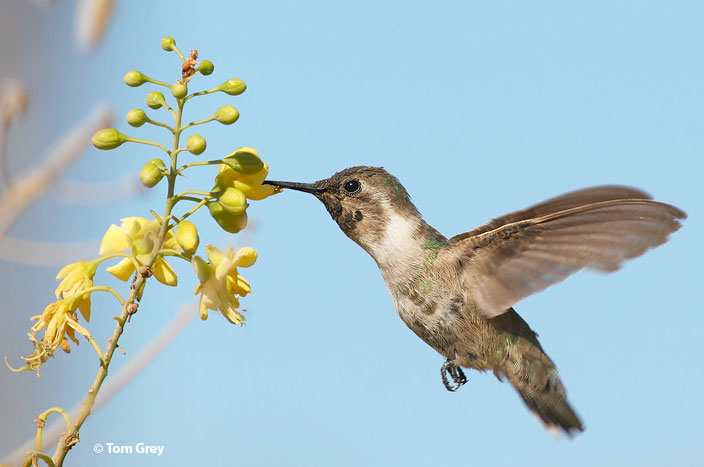Costa’s Hummingbird (Calypte costae) is a small species of hummingbird named after Louis Costa, a hummingbird collector.
They grow up to 3.5 inches long, which is small even for a hummingbird, and live up to 9 years old. This species differs from other hummingbirds because of its stunning purple face and throat. It has a dark droopy bill, chubby body, and short tail – all of which help you separate it from other hummingbird species.
Costa’s Hummingbird range is quite small, as it mostly lives in arid desert areas, but therein they are a common sight, and their population can be described as fairly stable or slightly declining.
On this page
Breeding Male
Male Costa’s Hummingbird has a bright, deep purple face and throat, with feathers sticking out to both sides like a mustache. It also has white “eyebrows.” The plumage on its back and underbelly is pale green and white. Males don’t call, they sing very thin, high-pitched whistle-like notes.
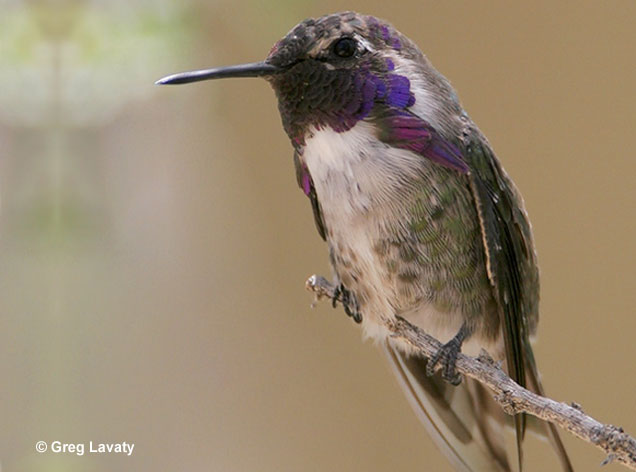
Female
Female Costa’s Hummingbird is more modest than their male counterpart. Its plumage is green, and it has a whitish underbelly. Similar to the males, they also have pale eyebrows. Females call with sharp, dry tics.
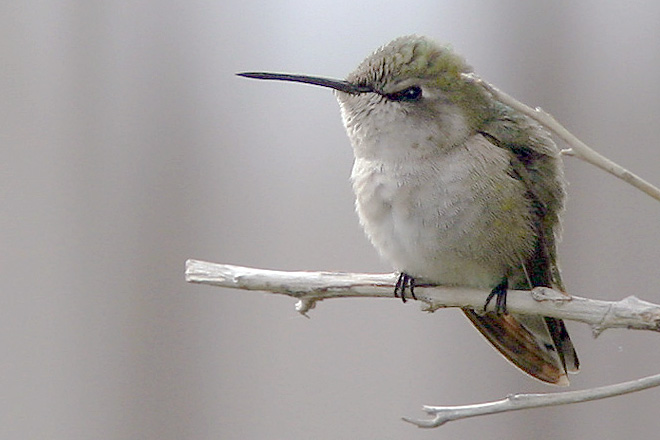
Photograph © Tom Grey.
Juvenile
The female can have 1-2 broods in one breeding season and usually lays two white eggs that are 0.3 inches wide and 0.4-0.6 inches in length, then incubates them for 15-18 days.
The hatchlings are dark-skinned and without feathers. They stay in the nest for around 20-30 days while the mother bird brings them food. Males do not help care for the young.
Juveniles resemble females, but as they age, you can see the males grow purple feathers on their necks.
Habitat
Costa’s Hummingbird habitats include hot and dry areas, such as deserts, where they are important pollinators. This species prefers having a good variety of plants.
The female builds the nest from plant fibers, bits of leaves or flowers, and even spider webs on a horizontal or diagonal branch 2-8 feet above the ground. Costa’s Hummingbird nest looks like an open cup, rather gray in color, is around an inch wide and deep, and takes about 4-5 days to build. They prefer open shrubs or small trees, sometimes even cacti.
Unfortunately, Costa’s Hummingbirds are threatened by urbanization, agriculture, and competition from other hummingbird species. Due to the loss of habitat, their population in desert areas has been in decline, but some have adapted to living or visiting suburban gardens for nectar and sugar water from the feeders.
Diet
Similar to other hummingbird species, Costa’s Hummingbird feeds on nectar and small insects they find flying or in the flower petals.
In deserts, they prefer to feed on chuparosa, agave, desert honeysuckle, and ocotillo, whereas in California coastal areas they can be seen around white and black sage, heart-leaved penstemon, and bush monkeyflower.
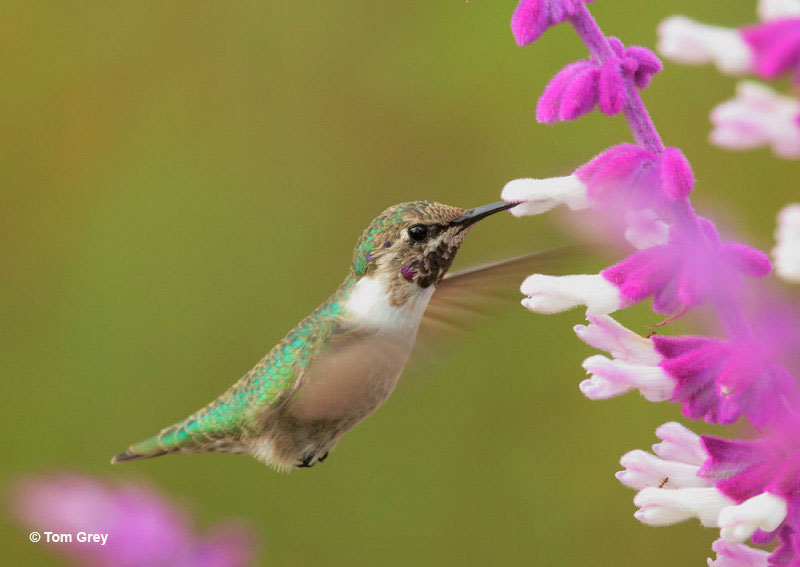
© Tom Grey
They usually hover, extending their bill into the flower. Sometimes they can also be attracted by bird feeders designed for hummingbirds where they either hover or perch and drink sugar water. To catch insects, they either hover and pluck them from the flowers or fly out to snatch them midair.
Behavior
Male Costa’s Hummingbird will perform loops and dives around the female he’s interested in, letting out high-pitched whistles. This display goes on for about 35 seconds, but it has been observed to last up to 4 minutes. If the female is disinterested, the male hovers directly in front of her with his purple feathers flared.
Costa’s Hummingbirds are not monogamous. The males will mate with multiple females and then leave the mother birds to care for the young. However, they defend the nest and food sources during the breeding season, picking several spots within their territory to perch on. They let out high-pitched whistles to lay claim and keep intruders out. Intruders can be snakes, lizards, small animals, and larger birds.
Both males and females defend their food sources during the non-breeding season. However, they are one of the smaller species and will surrender to bigger and more aggressive species of hummingbirds.
Range (and seasonal changes)
Costa’s Hummingbirds can be found in scrubby deserts (specifically in the Sonoran and the Mojave Deserts) below 3,000 feet elevation in the southwestern U.S., western Mexico, and the Baja California Peninsula of Mexico. They are short-distance migrants.
Most birds migrate toward the coastal areas when the spring-time breeding season in deserts is over, although they remain put in places where flowers are present year-round, such as suburban gardens.
Wing shape
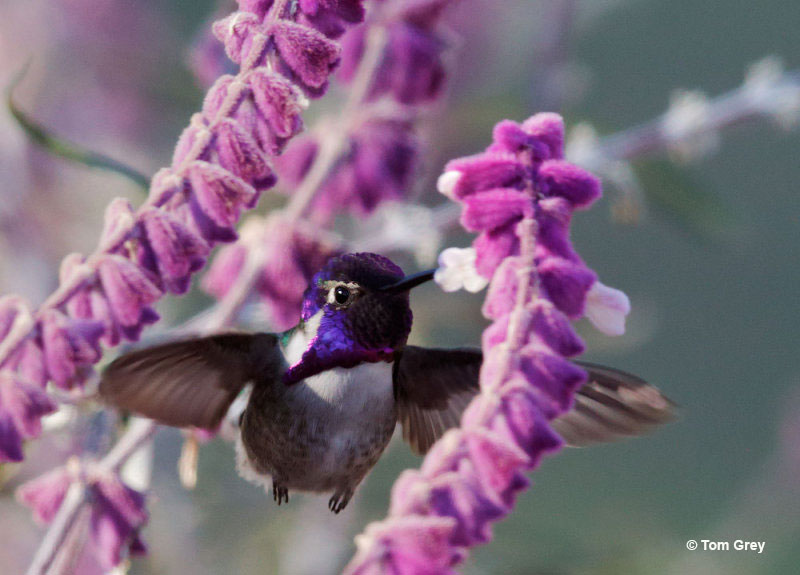
© Tom Grey
Similar to other hummingbirds, Costa’s Hummingbird’s wings allow them to hover, fly forward and backward, and even fly upside-down for a short time. This allows them to maneuver quickly and hover to collect nectar from the flowers.
Fun Facts
- During cold nights, Costa’s Hummingbird can slow down its metabolism, heartbeat, and respiration rate, which makes it enter a state of hibernation.
- For those who believe, spotting a hummingbird can signal that challenging times are over, healing can begin. They symbolize hope and good luck.
- Costa’s Hummingbird needs to visit approximately 1,840 flowers to meet its energy requirements for one day.
Vocalization
Vocalization is different for male and female birds. Male Costa’s Hummingbird sings 4 thin, high-pitched whistle notes that are less than one second long when perching and overlooking its territory.
During looping and diving displays, the pitch of his whistle rises and falls, and it lasts about two and a half seconds. The females don’t sing but call with sharp, dry tics. The males rarely call, but when they do, they do it in a sing-song fashion or give a series of tics.
Similar Species
Costa’s Hummingbirds are mostly easy to identify, but we’ve gathered some similar hummingbirds that can be mistaken as Costa’s Hummingbirds:
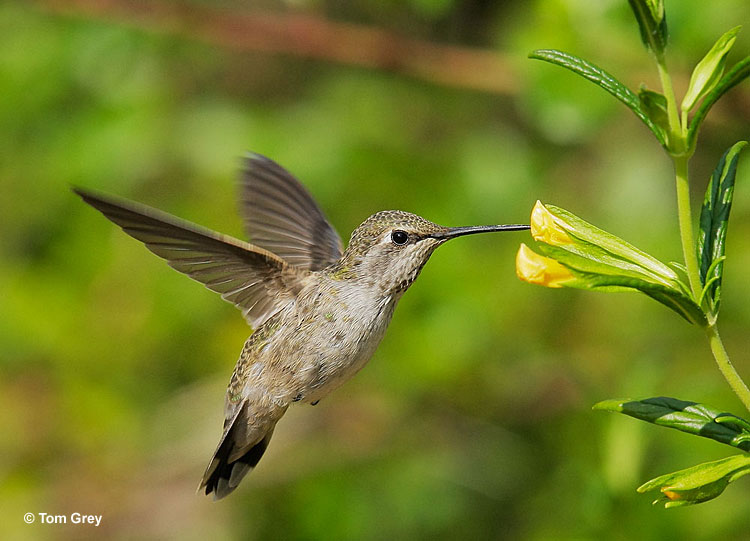
Female Anna’s Hummingbird
While Anna’s Hummingbirds do not look too similar at first sight, female specimens look strikingly similar.
The only difference these two females have, is that Anna’s Hummingbirds have a small patch of darker/red feathers on their chins.
Costa’s Hummingbirds do not have this patch.
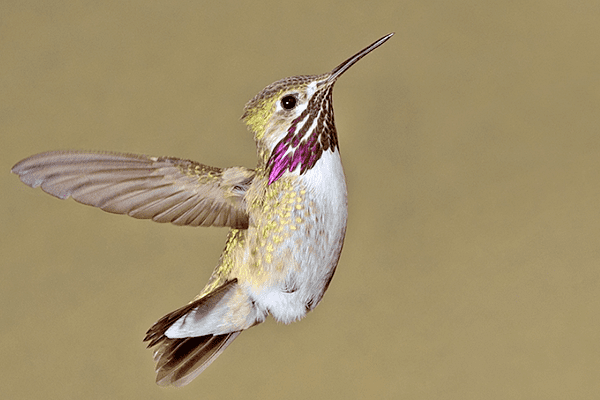
Calliope Hummingbird. Photograph © Alan Wilson.
Costa’s Hummingbirds have a mask of purplish feathers on their face.
Calliope Hummingbirds look similar, but they are known for the pinkish-purple gorget, which looks like it starts from their bills.
Frequently Asked Questions
Why is the Costa Hummingbird endangered?
Costa’s Hummingbirds are endangered because of the loss of habitat caused by urbanization, agricultural activity, and competition from other hummingbird species.
Where do Costa’s Hummingbirds live?
Costa’s Hummingbirds live in arid dry areas, such as deserts, specifically in the Sonoran and Mojave Deserts. They live in the southwestern U.S., western Mexico, and the Baja California Peninsula of Mexico.
How long do Costa’s Hummingbirds live?
Costa’s Hummingbirds live for 9 years on average.

